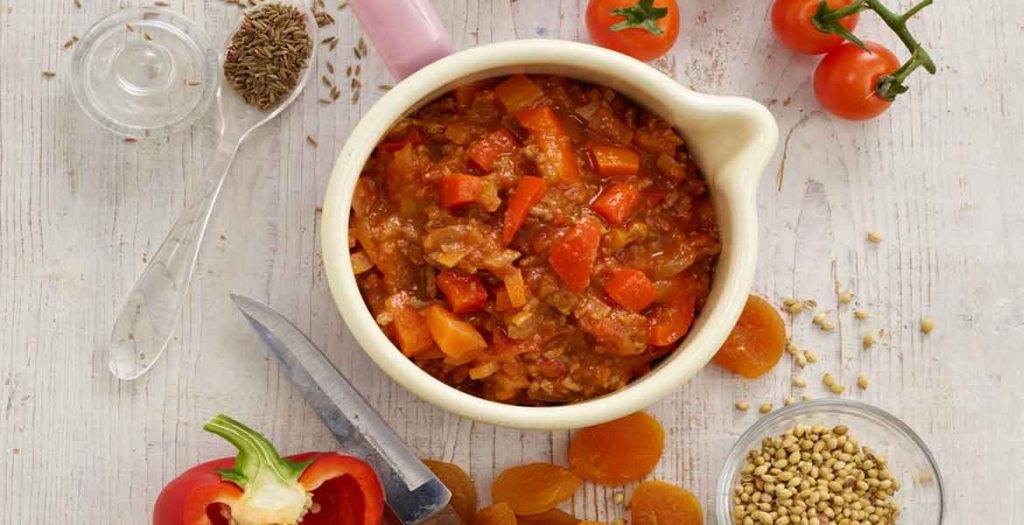
Discover how to add taste and texture to your baby’s food
Up until now your baby has been content with breast or formula milk whilst dabbling in the delights of puréed fruits and root veggies, but now’s the time to let them discover a world of tastes and textures.
Between six and nine months, once first tastes have been accepted and your baby’s digestive system is maturing, you can start to increase the amount and variety of food you give to your baby. Babies are developing really quite rapidly at this stage, so this is a window of opportunity to help them master the fine art of chewing.
The key to introducing tastes and textures successfully is to take it slow and follow your baby’s pace – after all, the experience can be quite daunting for them. There’s no point in pushing them when they’re not ready as they’ll just kick up a fuss and it will be harder next time around. You simply have to be patient and persistent.
Tackling texture
So you’re a first foods pro but now tackling texture? Don’t worry if you’re unsure where to start, just follow our top tips to introducing texture.
- Make purées thicker
Start by making the consistency of the purée thicker. Try mashing a portion of your baby’s food, then adding it to the purée, gradually increasing the ratio of mashed to puréed food. Once she’s happy with a thicker texture, you can slowly stop puréeing and simply just mash the food by hand.
- Finely chop the veggies
Dicing vegetables finely is also a good way to introduce texture. Start by softening small cubes of carrots or apple which will allow your baby’ gums to squash them when they try to chew. Be careful when you do this, as surprise chunks can really startle your baby and put them off. Making your own baby food will allow you to control the size of the lumps and, in turn, you can gradually increase their size.
- Add chunkier foods
With my son Nicholas I soon realised that if I added baby pasta shapes to his favourite purée, then he was more receptive because it was a flavour he was familiar with. Give rice or couscous a go too – you might be surprised at what gets wolfed down. For a sweeter option, try cereal or porridge with a little cow’s milk which can now be introduced when your baby is six months plus.
![Mini-Chicken-Balls[4]](https://bbabymagazine.co.uk/wp-content/uploads/2016/06/Mini-Chicken-Balls4-300x300.jpg)
Conquering tastes
I never liked bland baby food. I could never find anything that Nicholas would eat which is why I set about devising my own recipes. I began experimenting with garlic, herbs and spices to liven-up his food and that’s how I stumbled upon winning flavour combinations which I published in my Complete Baby and Toddler Meal Planner cookbook.
<h4>Experiment with garlic, herbs and spices</h4>
At this stage it’s important to avoid salt, sugar and honey so instead try thyme, bay leaves, parsley, dried oregano, ground coriander and cinnamon etc… If using a stock cube for flavour, make sure you use unsalted cubes. It’s surprising how these ingredients really pack in a punch of flavour and often it’s a taste your baby will love.
Cooking chicken
Chicken is an ideal first meat, as it blends well with root vegetables and fruits. It’s also packed with protein and vitamin B12 to help your baby grow. Chicken can be diced finely and blended with sweet potato and apple or butternut squash and tarragon for a delicious meal. I would advise that as well as chicken breast try also using the thigh meat – the dark meat of chicken contains twice as much iron and zinc as the white.
Feeding fish
Fish is a tricky ingredient to get babies eating, particularly because it’s bland and can be tough when overcooked making it harder to swallow. Fish like salmon or cod provide the important fatty acids needed to help aid your baby’s brain, nervous system and vision development. Try mixing fish with stronger tastes like carrots, tomato and grated cheddar. Always check for bones before serving.
Important iron
Babies are born with a store of iron inherited from their mother. At six months this begins to run low, so introduce foods rich in iron such as meat, leafy green vegetables and pulses. Vitamin C can help aid the absorption of iron, so give foods such as broccoli or citrus fruits.

Happy weaning!
